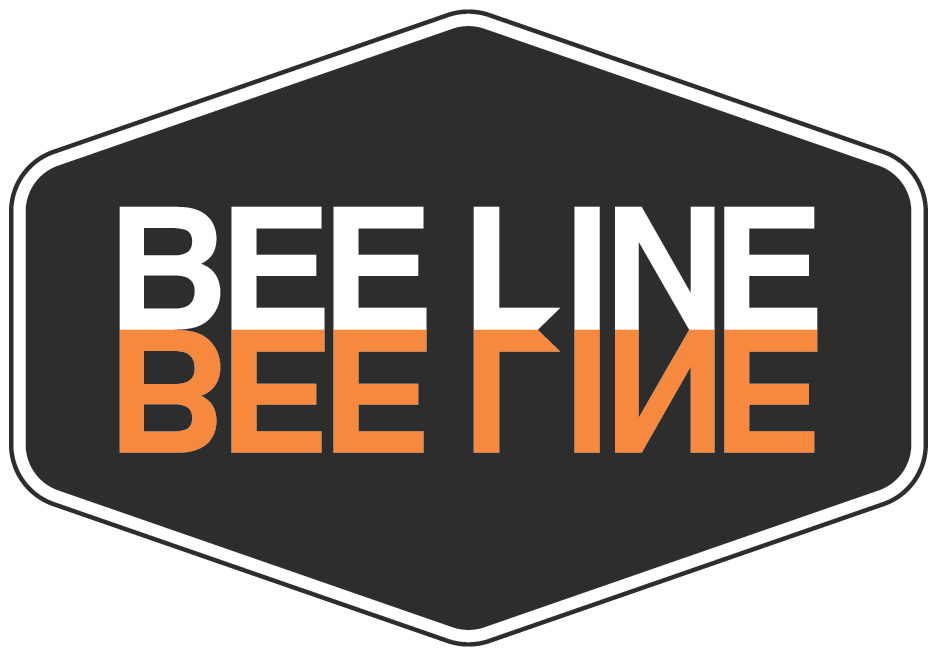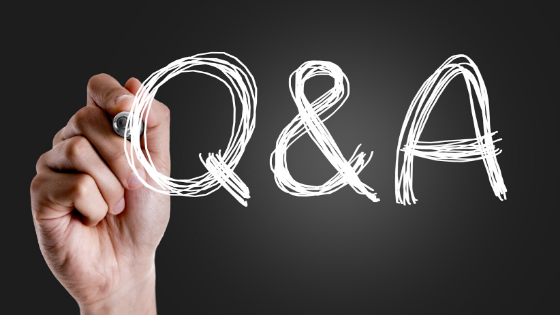It’s becoming clear that the threat of COVID-19 and its re-emergence is our new normal indefinitely. With that in mind, now is the time to take initiative to dive in and learn everything that we can about this virus, along with how to fight it and prevent it, in order to move towards a healthier and brighter future.
We sat down with Tom Klimaszewski, our Certified Safety and Compliance Manager. With 7+ years of experience as a Safety and Compliance Manager under his belt, along with a B.S. in Environmental Studies and a Certificate of Mastery in Infection Prevention (CMIP) and Trainer for Certified Surgical Cleaning Technician (T-CSCT) Certification, we couldn’t think of a better knowledge-source to turn to.
How do you clean different surfaces to remove the COVID-19 virus (for example: wood, cloth, metal)?

This virus obviously cannot be seen by the naked eye so we must first have a general understanding of the pathogen we are targeting. This non-living virus has a circular lipid layer surrounding some genetic material that when in contact with human cells, can replicate rather quickly. We must, therefore, destroy that outer coating of the virus, making it inactive and incapable of infecting us. If there is any organic matter or inorganic matter on a surface, you must first clean it from a surface.
Once soiled surfaces are cleaned, a disinfectant can be applied and allowed to remain wet for the given contact time to kill the virus. For surfaces that are more porous such as cloth or fabric, I would suggest having them laundered with detergent using hot water or a steam cleaner.
What’s the active timeframe for the virus on different surfaces (wood, fabric, copper, metal, cardboard, porous/non-porous surfaces)?
Studies have shown that the COVID-19 virus can remain active on certain surfaces longer than others. It seems to survive longer on non-porous surfaces such as glass, stainless steel and plastics anywhere from three to five days and some porous surfaces such as cardboard or fabric for up to 24 hours. This type of virus doesn’t seem to like any type of surface that is porous or has small tiny holes but rather prefers smooth surfaces such as metal and plastic.
What are the Do’s and Don’t of mixing chemicals for the household?
Since the COVID-19 pandemic began, poison control centers have received a big spike in calls from accidents relating to chemical use. You should never mix chemicals, especially if they are pre-diluted or ready to use. Mixing bleach with vinegar or ammonia can create deadly gases and vapors. Always read the labels of chemicals for proper use and ensure to work in a well-ventilated area.
What is the protocol for cleaning multiple areas as it relates to the tools (rag, paper towels, sponge, mops, gloves, goggles) that are being used? What do I do differently because of COVID-19?
Paper towels would be ideal for cleaning and wiping surfaces as they can be discarded once soiled. Rags and mops can also be used while cleaning, however, they would have to be properly laundered using detergent and hot water. Disposable gloves would be ideal when cleaning or using chemicals during the cleaning and disinfection process. Goggles can also be used to help prevent exposures or inadvertent sprays to the eyes from chemicals. Remove personal protective equipment properly when finished and always ensure to perform hand hygiene immediately afterward.
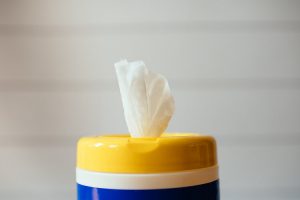
What are some strategies to prevent cross-contamination?
A rag or towel can be folded multiple times, creating a fresh surface for wiping. Always ensure to separate soiled towels or rags from those that are clean and change gloves often to prevent any further contamination. Identify surfaces which may be dirtier than others and always work from clean to dirty. High touchpoints such as door handles or elevator buttons will be dirtier than certain pieces of furniture or furniture in a much less frequented areas of a room. Work from top to bottom and left to right to ensure all areas are targeted.
How often should I change my cleaning tools (by item, area, time, etc.)?
Disposable cleaning tools should be changed as often as possible and fully cleaned between each use. Avoid using the same rags or towels in bathrooms or kitchens.
What cleaning product should we use today vs before COVID?
Some of the products that are effective at killing the COVID virus may have been used by people before the COVID pandemic began because they were effective at killing multiple pathogens on surfaces. The COVID virus is a new strain of a Coronavirus so there wasn’t a chemical on the market that could make that kill claim on their label. Over time, the EPA has approved numerous chemicals that are capable of killing certain viruses, deeming them to be effective at killing the COVID virus.
What is the difference between sanitizing vs cleaning?
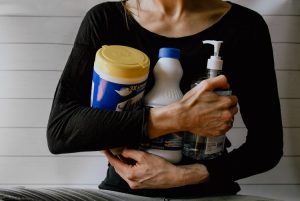
Cleaning is the process of taking something from an undesirable location to a more desirable one, such as trash or soil from a surface. When you sanitize, bacteria is removed from a surface making it safe for food to be placed on that surface.
This is a term often used in a restaurant setting to satisfy public health standards but it may not remove certain viruses from surfaces. Disinfecting is the process of killing most bacteria and viruses on a surface. Strong disinfectants are used with specific dwell or kill times in order to be effective at killing all the pathogens it claims.
What PPE can I use if I don’t have a large supply?
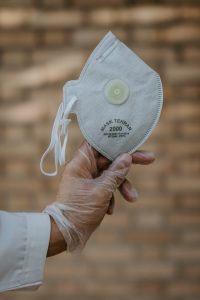
You should always wear gloves when using chemicals that are classified as skin irritants. Masks and eye protection may not always be necessary so as long as you work with certain chemicals in well-ventilated areas and use the chemical safely. Always perform hand hygiene after using cleaning products to reduce any chemical exposure.
What PPE should I advocate for at work?
One should wear the appropriate PPE (Personal Protective Equipment) for the necessary precautions at hand. For contact precautions, one should wear gloves, gowns or scrubs, and shoe covers. For droplet precautions, one should wear gloves, gowns/scrubs, shoe covers, and a face shield or mask and eye protection. For airborne precautions, one should wear gloves, gowns/scrubs, shoe covers, eye protection, and a respirator. PPE should also be properly fitting and replaced when damaged.
How should one dispose of trash?
Trash receptacles can be a petri dish of harmful germs and should be regularly cleaned and disinfected. Always ensure to use rigid bags to prevent contents from leaking and never push down trash with your hand or feet in order to close the bag. Use a single knot instead of a bunny ear not to keep the bag from easily spilling the contents inside.
What cleaning solutions do you suggest that can be purchased from the store?
Check the latest list of EPA approved products that are effective for use against SARS-CoV-2 (COVID-19). Many Clorox and Lysol products can be easily found in your local store. The CDC also recommends using a bleach and water mix to kill the virus on surfaces.
What commonly used areas need special attention (restrooms, kitchen, break area, hallways)?
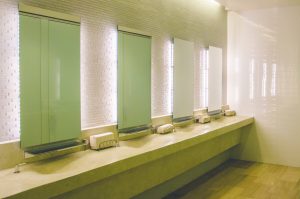
Typically, restrooms and kitchens get the most attention but you shouldn’t neglect other areas of a building. To prevent the spread of a contagious virus, identify areas that are frequently touched and ensure to clean and disinfect them properly. People still have many habits that are hard to break such as touching their faces and not always washing their hands. By cleaning and disinfecting high touchpoints, we can help reduce the spread of the virus.
What can I reuse vs what should be disposed of after cleaning?
You can reuse cloths or mops used for cleaning as long as they are laundered properly after use. Disposable items such as gloves and paper towels should be thrown away immediately.
Can I wipe surfaces dry or do they have to air dry?
If you are using a disinfectant with specific dwell times, always allow the chemical to remain wet on the surface for the appropriate time. Once the specific time elapses, you can either wipe it off the surface to prevent a layer of film or let it air dry.
What common household cleaning solutions (homemade) can we use?
Regular soap and water can help with inactivating this virus from surfaces. It may not be as effective as certain chemicals but it can rid surfaces of germs. Isopropyl alcohol can be used as long as it has a 70% alcohol solution. Hydrogen peroxide can also be used but be careful as this can discolor fabrics. Lastly, a diluted household bleach solution can be used to kill many microorganisms that can live on surfaces.
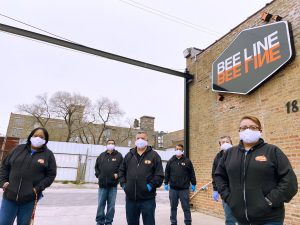
There’s clean. And then there’s Bee Line clean.
As many of us prepare to welcome our teams back to the office, now is the time to consider our workers’ safety and reassure them that they’re returning to a safe working environment. Now is the time to enlist the support of Bee Line Support, a Chicago-based, medical-grade, COVID cleaning company that has been showing up every single day during this pandemic to ensure that our community is kept healthy and safe.
As one of the only cleaning companies in the region that is certified in infection prevention, we are trained in targeting and destroying viruses, including the COVID-19 virus, through a unique misting technology and high-touch cleaning protocol that leaves your space spotless. We have worked hard to build up a staff of over 475 employees who are trained and quickly deployable to meet any of your deep cleaning needs at any point.
If you do choose to sign up for disinfecting services with us, we will also provide you with decals after the service (see below) that you can post throughout your facility to reassure your staff and visitors that you’ve been thoroughly cleaned and disinfected by a professional cleaning company.
Check out the links below for our COVID-19 killing services, which will bolster your health and success as you navigate the return-to-work during these trying times.
Bee Line’s Coronavirus Misting Service
About The Author
Tom Klimaszewski
author
Tom is your go-to-guy for any health and safety concerns on-site! Tom has lots of experience as a Safety and Compliance Manager in commercial cleaning, healthcare, office, airport settings, with his education in Environmental Studies. He has earned his Certificate Mastery in Infection Prevention (CMIP) and Trainer for Certified Surgical Cleaning Technician (T-CSCT), so to say he’s knowledgeable would be an understatement. When he’s not combatting germs, you can find Tom painting, writing songs, hiking, fishing, and belting out his favorite tunes at karaoke! His favorite part of working with Bee Line is the collaborative and supportive environment.
